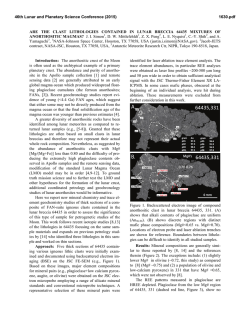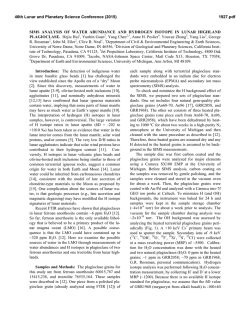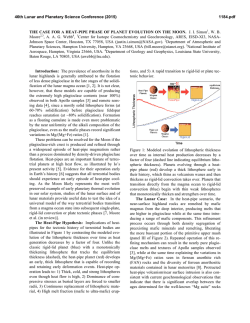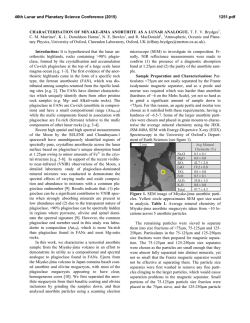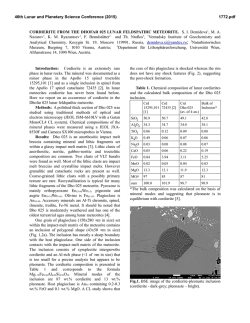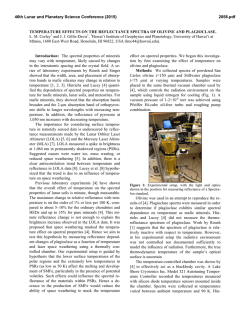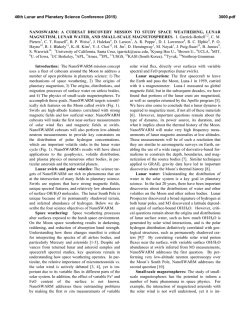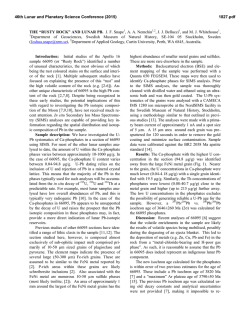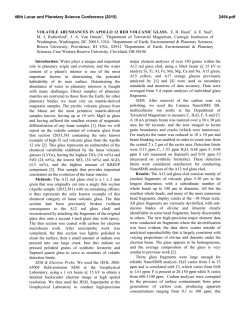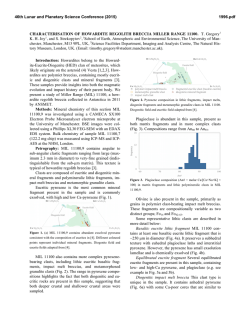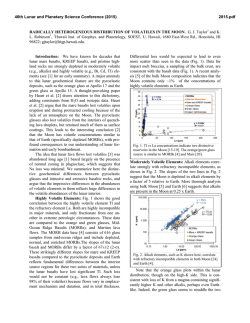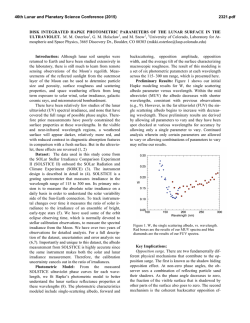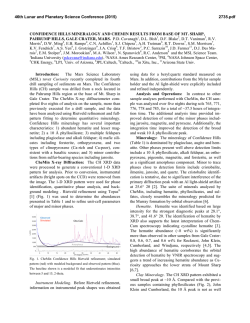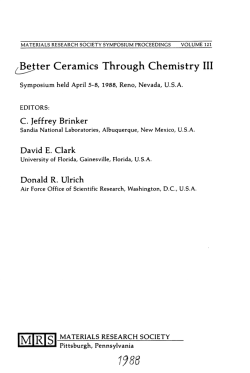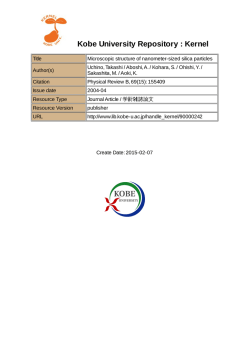
synthesis of “large” iron-bearing anorthitic plagioclase crystals for
46th Lunar and Planetary Science Conference (2015) 1804.pdf SYNTHESIS OF “LARGE” IRON-BEARING ANORTHITIC PLAGIOCLASE CRYSTALS FOR LUNAR SPECTROSCOPIC AND SPACE WEATHERING STUDIES N. J. DiFrancesco,1 A. E. Coraor,1,2 H. Nekvasil,1 D. H. Lindsley1, A. Sinclair1, S. J. Jaret1, and T. Glotch. 1Stony Brook University, Dept. of Geosciences, Earth and Space Science Building, Stony Brook, NY 11794. [email protected]. 2Cornell University, Ithaca, NY. Introduction: Lunar anorthosites dominate the highlands of the Moon’s surface and are considered old remnants of the Lunar Magma Ocean (LMO) [1]. Much of this anorthosite is considered to be ferroan anorthosite (FAN), in which plagioclase is strongly calcic (>An95) and contains measurable amounts of Fe, as visible metallic iron inclusions [2] and as structural Fe (either ferrous or ferric [3]). While Fe3+ can substitute for Al in tetrahedral crystallographic sites; the majority of the structural Fe component is likely ferrous iron that is substituting for Ca in the octahedral site of the plagioclase structure [4]. A wealth of knowledge can be extracted from lunar samples in the Apollo and Luna collections, yet the vast majority of the lunar surface has only been studied from orbital measurements. Visible near infrared (VNIR) and thermal infrared (TIR) spectroscopy have been valuable tools in ascertaining the mineralogy of the lunar surface at global and regional scales. In order to better constrain compositional information in analyses of data collected from orbit, it is necessary to better understand the physical properties of the Fe-bearing anorthitic plagioclase. However, because of the value and paucity of natural lunar samples as well as the polyphase nature of specimens, we have launched a major synthesis effort to produce a recipe for growing large plagioclase crystals under lunar conditions free of other mineral or glass phases. The goals are to produce plagioclase crystals that are: 1- highly calcic (An95-98); 2- Fe-bearing (between ~0.05 and ~0.5 wt. % FeO) to approximate concentrations in other lunar FAN plagioclase [5, 6]; and 3large enough in size to provide information on the effect of grain size on VNIR and TIR spectra. The plagioclase must be free of other phases (other than metallic iron), and simulate those formed under lunar conditions (e.g., low oxygen fugacity). Experimental Strategy: Synthesizing “large” phenocrysts of Fe-bearing anorthitic plagioclase with any extent of compositional control poses unique challenges to experimental petrologists because of its high melting point (1553ºC), the need to maintain low oxygen fugacity, concerns regarding Na retention, and multiple inherent difficulties associated with controlling the grain size of plagioclase in the laboratory. Attempts to react the chemical components at sub-solidus conditions yielded an aggregate of crystals < 5μm in length, that is, crystals of insufficient size for the pur- poses of this study. In order to minimize nucleation (and maximize crystal growth) we designed the synthesis experiments to be crystallization experiments from a melt. Furthermore, to make it possible to use Fecapsules, to produce plagioclase with Fe contents that would be expected for anorthitic plagioclase in equilibrium with ferromagnesian minerals, and to ensure easy separation of plagioclase crystals from all other phases, we chose bulk compositions that (i) would have plagioclase on the liquidus, (ii) would avoid early saturation with spinel, (iii) if allowed to cool close to the solidus temperature would crystallize olivine or pyroxene and yield Mg#’s consistent with those of FAN, and (iv) would take advantage of the freezing point depression of multi-component melts. As shown in Fig. 1, it would not be possible to attain these goals by staying within the An95-olivine subsystems because of the presence of the spinel + L field. Since the presence of an additional silica component diminishes the spinel field (Fig. 1) a composition was chosen in the An95-olivine-silica system. The composition chosen for the synthesis results discussed here is [(An95)75(Fo50)25)]90[SiO2]10 Figure 1- 1atm Anorthite-Forsterite-Silica ternary diagram after Andersen [7]. Experimental Methods: The selected composition was synthesized from SiO2, CaSiO3, Na2SiO5, Fe2O3, MgO, Al2O3, and Fe0. These powders were weighed, and ground in alcohol together for homogenization prior to the addition of the Fe components. Fe-sponge was then added with minimal additional grinding. The 46th Lunar and Planetary Science Conference (2015) mixture was loaded into high purity Fe capsules with tightfitting lids. Each capsule was placed inside an evacuated silica glass tube, and dried in the presence of an Fe-sponge oxygen “getter” at approximately 800ºC for 10 minutes. After drying, and while still under vacuum, the sample’s silica glass tube was partially filled with approximately 0.5 atm of N2 gas to prevent both the silica glass tube from losing integrity and the melt from escaping the capsule. The tube was then sealed shut with a torch creating an ampule (Fig. 2). This ampule was placed inside a Deltec furnace, which was taken to 1350ºC for 2 hours to melt. 1804.pdf glass. Crystals of plagioclase separated were >1mm in size (Fig. 3). While lunar FANs are all extremely high in Ca, they do exist over a limited range of compositions. Therefore, a second composition of An98 plagioclase, with similar olivine and silica components is currently being produced. Further modification of olivine composition or silica content may also be desired. Using these synthesized plagioclase samples, it should be possible to develop optical constants to better constrain orbital observations of ferroan anorthosite in the lunar highlands. Avg Plag 1 Plag 2 Plag 3 (n=11) SiO2 45.60 44.96 44.35 44.95 Al2O3 35.57 35.84 35.36 35.23 FeO 0.21 0.30 0.19 0.32 MgO 0.27 0.32 0.28 0.31 CaO 18.44 18.71 18.50 18.38 Na2O 0.39 0.45 0.48 0.52 Total 100.93 100.96 99.61 100.10 AN 96.30 95.81 95.55 95.26 Table 1- Analyses of plagioclase grains from ferroan anorthite synthesis. Figure 2- Iron capsules loaded with powdered sample before and after being placed inside sealed silica glass tube. Bottom scale in cm. After completely melting the sample, the temperature of the furnace was gradually lowered over several days to 1150°C. The ampule was then removed from the furnace and quenched into liquid gallium. We hypothesized that the extended period of cooling would help promote crystal growth, maximizing the size of plagioclase crystals. Experimental results: The run products consist of plagioclase and glass, with no evidence of either spinel, olivine or pyroxene. Plagioclase was analyzed using the Cameca SX100 electron microprobe at the American Museum of Natural History. Analyses were carried out using a 20 nA beam current and a focused electron beam with a 5μm spot size. There was no indication of any loss of Na during chemical analysis. Table 1 indicates the resulting plagioclase compositions for this synthesis. An contents and Fe concentrations for all of the grains analyzed were within the range acceptable for FAN suite rocks. In order to use the synthetic plagioclase for spectroscopic study, crystals needed to be separated from glass, while preserving the size of the plagioclase as much as possible. To do this we used a SELFRAG high voltage pulsed power dissaggrefation system that Figure 3- Crystals of synthetic plagioclase separated from interstitial glass by SELFRAG. Acknowledgements: This work was supported by the RIS4E SSERVI team. References: [1]Wood, J.A. (1975) Proc. of the 6th Lunar Sci. Conf. pp 1087-1102 [2] Warren, P.A., Jerde, E.A., & Kallemeyn, G.W. (1987) JGR 92 B4 pp. E303-E313 [3] Nieburhr, H.H., Zeira, S., & Hafner, S.S. (1973) Proc. of the 4h Lunar Sci. Conf. pp 971982. [4] Cheek, L.C. et al. (2011) Proc. of the 42th Lunar Sci. Conf. Abstr #1617 [5] Floss, C. et al. (1998) GCA 62, 7. pp 1255-1283. [6] Ryder, G. & Norman, M.D (1980) Cat. Of Ap. 16 Rocks. NASA, JSC. [7] Andersen, O. (1915) Am. J. of Sci. 4th Ser. Vol 39. 232 pp 407-454.
© Copyright 2025
